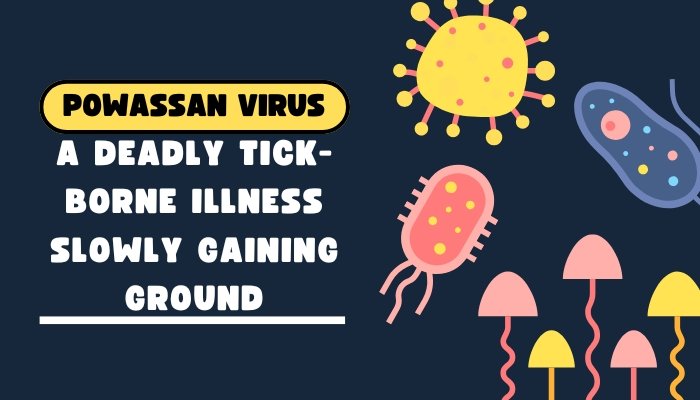Powassan virus, a rare but serious tick-borne disease, has quietly surfaced as a growing threat in parts of the United States. Carried primarily by the same deer ticks (Ixodes scapularis) responsible for Lyme disease, this virus can cause severe neurological complications, including swelling of the brain and spinal cord.

While confirmed cases remain relatively low, a fourfold increase has been reported in the past decade—from 64 cases to about 270—reflecting a concerning expansion into new areas of the Northeast and Great Lakes regions.
This article explains what Powassan virus is, how it’s transmitted, the symptoms it causes, and essential strategies to stay protected as tick populations advance.
Introduction
For many Americans in tick-endemic areas, Lyme disease looms large as a well-known threat. Yet Powassan virus—though still uncommon—presents a more lethal, fast-acting danger if transmitted. Initial infections can go unnoticed or appear mild, but in a subset of cases, patients quickly develop encephalitis or meningitis, potentially resulting in neurological damage or even death. As deer tick populations expand along with warmer climates and greater woodland-human interfaces, the risk of encountering Powassan virus–carrying ticks has grown.
Awareness of Powassan virus is crucial for anyone spending time outdoors—particularly hikers, campers, or residents in heavily wooded or brushy regions. Quick, proper removal of ticks and adherence to preventative measures can minimize the risk of infection. Meanwhile, public health officials, clinicians, and researchers strive to raise recognition of this under-the-radar illness to support earlier diagnoses and better outcomes.
Understanding Powassan Virus
A Flavivirus
Powassan virus belongs to the Flavivirus family, which includes other arthropod-borne viruses like West Nile and dengue. Named after Powassan, Ontario (where it was first identified in 1958), this virus naturally cycles between ticks and small mammals. When a tick carrying Powassan bites humans, it can pass the virus, potentially leading to infection in the central nervous system.
Two Lineages: POWV and DTV
- Lineage I (Powassan virus lineage): Historically associated with woodchuck ticks, found in Canada and the northeastern U.S.
- Lineage II (Deer tick virus, DTV): Linked to deer ticks (Ixodes scapularis), which also transmit Lyme-causing Borrelia burgdorferi. DTV lineage is more common in recent U.S. cases.
Transmission and Tick Ecology
The Deer Tick Connection
Deer ticks (also known as black-legged ticks) typically feed on white-footed mice, chipmunks, and deer, carrying pathogens like Lyme disease spirochetes, Anaplasma, Babesia, and occasionally Powassan virus. Transmission can occur quickly—Powassan virus may pass to a person within 15 minutes of tick attachment (versus 24–48 hours for Lyme). This brief transmission window complicates prevention efforts and underscores the importance of detecting and removing ticks promptly.
Environmental Drivers
- Growing Tick Habitat: Warmer winters, land-use changes, and expanding deer populations have extended the range and density of ticks in some states.
- Ecological Interactions: More human recreation in wooded areas elevates exposure risks, especially in late spring and summer months.
Geographic Range and Rising Incidence
Historically Rare
Powassan virus has been around for decades but was rarely diagnosed or recognized. Early cases largely clustered in the northern states (Maine, Minnesota, Wisconsin) and parts of eastern Canada.
Fourfold Increase
Over the past decade, annual reported cases jumped from around 64 to approximately 270—a small fraction compared to Lyme disease totals, but worrying for its potential severity. This upsurge:
- Reflects: Improved testing and greater awareness by health departments.
- Suggests: Tick infiltration into new counties or expansions of known tick habitats.
High-Risk Regions
- Northeast: States like New York, Massachusetts, Connecticut, Maine have documented recent spikes.
- Great Lakes: Minnesota, Wisconsin, and surrounding areas note increasing detection.
Symptoms and Disease Progression
Early and Nonspecific
Some individuals experience mild symptoms or remain asymptomatic. Common early signs, if any, might include:
- Fever
- Headache
- Fatigue
- Muscle aches
Serious Neurological Outcomes
An unfortunate subset rapidly develops severe complications:
- Encephalitis: Inflammation of the brain with confusion, coordination loss, or seizures.
- Meningitis: Neck stiffness, severe headache, photophobia.
- Long-Term Neurological Damage: If the central nervous system is extensively affected, survivors might face lasting neurological deficits.
Case Fatality Rate
Although the overall incidence is low, 10–15% of documented severe cases can be fatal, highlighting the virus’s potential danger compared to more common tick-borne illnesses.
Diagnosis and Treatment
Diagnostic Challenges
Diagnosis can be tricky because early flu-like symptoms overlap with other viruses. Specific measures:
- Serological Tests: Checking for Powassan virus–specific IgM and IgG antibodies in blood or cerebrospinal fluid.
- PCR: Occasionally used if early testing is done during active viremia.
No Specific Antiviral
Like many arboviruses, no targeted antivirals exist for Powassan. Management typically includes:
- Supportive Care: IV fluids, pain management, monitoring in hospital if neurological symptoms worsen.
- Neurological Support: In severe encephalitis, patients may require ventilatory support or rehabilitation for motor/cognitive deficits.
Prevention and Public Awareness
- Avoid Tick Habitats
- Use insect repellent containing DEET or picaridin.
- Wear long sleeves and pants, tuck them in socks, especially in woodland or grassy areas.
- Tick Checks
- Inspect your entire body for ticks after outdoor activities.
- Showering soon after possible exposure can help dislodge unattached ticks.
- Prompt Tick Removal
- Use fine-tipped tweezers, grasp the tick close to the skin, pull upward gently.
- Clean the area with alcohol or soap to reduce secondary infection risks.
- Landscaping Strategies
- Mow lawns, remove leaf litter, and create a barrier (gravel, mulch) between your yard and wooded areas.
- Spread the Word
- Local health agencies and community groups can inform hikers, campers, and homeowners about the rising threat of Powassan virus.
Research and Future Directions
- Vaccine Development: Researchers are exploring vaccines for multiple tick-borne viruses, though none are near commercial release for Powassan.
- Enhanced Surveillance: Collaboration between public health departments and wildlife ecologists can track tick distribution to forecast outbreak hotspots.
- Immunotherapy: Investigations into monoclonal antibodies or novel antivirals remain in preliminary stages.
Conclusion
As ticks expand into new territories, and humans spend more time outdoors, Powassan virus—once considered a rare novelty—poses an emerging threat. Despite low overall case numbers, its severity, speed of transmission, and rising incidence in the Northeast and Great Lakes states underscore the need for vigilance. From consistent tick checks and better public awareness to ongoing research into potential treatments or vaccines, a multipronged approach is vital to contain this “silent but dangerous” infection. By adopting preventive strategies and recognizing early symptoms, individuals and communities can stay safer in the face of this evolving viral challenge.
References
- Centers for Disease Control and Prevention (CDC). Powassan virus. Updated 2022.
- Ebel G. Update on Powassan virus: Transmission, epidemiology, and pathogenesis. Curr Opin Infect Dis. 2019;32(4):321-328.
- Hermance ME, Thangamani S. Tick–virus–host interactions in Powassan virus pathogenesis. Future Virol. 2017;12(9):491-502.
- U.S. Geological Survey (USGS). Distribution and dynamics of deer tick populations. Accessed 2023.
- Main AJ, Carey AB, Downs WG. Powassan virus: a pressing threat. Am J Trop Med Hyg. 1979;28(2):162-167.
- White B, Joseph S. Emerging tick-borne viruses: spotlight on Powassan virus. Infect Dis Clin Pract. 2021;29(6):e512-e518.






